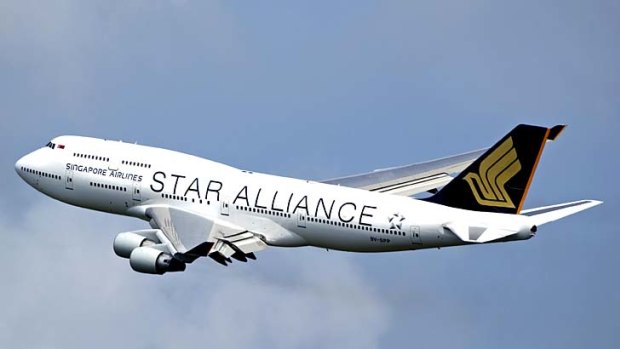This was published 12 years ago
End of an era: Singapore's jumbo makes final visit
The plane that built the Singapore Airlines (SIA) empire literally left town yesterday. One of the last three of SIA’s 747-400s flew out of Melbourne on Sunday morning, fully booked by a mixture of people who just needed to get to Singapore and beyond and a group of plane-spotting boffins who flock to these “last of/first of” historical occasions in aviation.
The airline wheeled out all of the milestone paraphernalia, including a 747 cake, to commemorate the retirement of SIA’s jumbo fleet, which has been flying to Australia for nearly 40 years.
“The 747 has played an integral part in Singapore Airlines' success, transforming us into a global carrier flying millions of customers across five continents,” the airline’s Australian manager Subhas Menon says. “We deployed our 747 fleet to our five Australian stations over the years, with Melbourne and Sydney in particular benefiting from the aircraft that came to epitomise the romance of air travel.

End of an era ... the last Singapore Airlines 747 jumbo jet flying into Australia has made its final visit.
“The 747 enabled us to become Australia's largest foreign carrier and we are absolutely delighted for Melbourne to have the honour of bidding farewell to the Queen of the Skies.
“The 747 has been a flagship in our fleet and leaves a long legacy of world firsts achieved by Singapore Airlines, from achieving milestones in non-stop flights to the introduction of the most innovative product and service features available.”
Of course, some of that is hyperbole, but SIA, along with the world’s travelling public, genuinely has a lot to thank this great old Boeing warhorse for.
Since 1973, SIA has owned a total of 86 copies of four different versions of the 747 and, not too many years ago, was one of the world’s biggest operators of the type, along with Japan Airlines (the world’s biggest 747 operator, which has now retired them) and Qantas.
Because of its gargantuan dimensions, the jumbo has always been popular with travellers; going for a wander mid-flight feels like exploring a city block and particular experiences stick in my mind.
Like the night in the late 1980s I headed for Tahiti on a Qantas 747-200 “Combi” (half freight, half passengers) en route from Sydney to Los Angeles. One of the stewards in economy class filled a sink with ice and cold drinks and invited us to take whatever we wanted – great service on that red-eye into Papeete that made our evening.
SIA liked the 747s so much it eventually gave them their own “brand”: its 15 747-300s, the first version with the extended upper deck delivered from 1983, became the "Big Top"; the 747-400s, in service from 1989, became the “Megatop”.
When SIA combined the 747’s unbeatable economics with its “Singapore Girl” marketing and in-flight service, the airline pulled away from the field as a world leader.
In-house, the real importance of that was that it no longer had to be the “price leader” to guarantee the airline’s future. It could, and still does, successfully charge more than the cheapest fare in town and the punters, from business travellers up the front to the holiday-makers down the back, are happy to pay a little extra for the experience.
SIA is using the A380 superjumbo in the same fare-boosting way, finding, along with other operators, that people are prepared to tailor their travel plans so they can fly on the big Airbus because of its quiet ride and the voluminous interior space.
- Flight test: Singapore Airlines A380
Singapore Airlines’ main workhorse these days, especially around Asia, is the Boeing 777-300, which is almost as big as the 747, but has great economics that make airline accountants excited.
However, I continue to read in feedback forums that many travellers find the 777 one of the noisiest rides in the sky.
The 747 isn’t dead yet, however. Germany’s Lufthansa is a strong believer in the passenger version of the latest jumbo, the 747-8I, which has been stretched to seat around 450 passengers in three classes, the same size as Qantas’s four-class A380s (Qantas is also hanging onto a small fleet of 747-400s with refurbished A380-style interiors to operate services chiefly to the US, South America and South Africa.)
Boeing claims the “-8” has superior economics compared with the A380, but it has sold only 36 passenger versions, on top of 70 orders for the freighter version.
However, because the “-8” is a derivative version, its development costs were a fraction of the estimated $12 billion it took to bring to fruition the A380, the Airbus that the European consortium had to build to break Boeing’s monopoly on the very-large-plane market. Airbus has so far sold just over 250 superjumbos, but industry watchers reckon it might have to sell another 160 (at up to $370 million each) to break even.
The last Singapore Airlines 747 flight will be on April 6, a return service from Singapore to Hong Kong.
Are you sorry to see the 747 disappearing from the skies? How does the 747 flying experience stack up against the A380 and others like the A330 and Boeing 777? Have you ever changed you travel plans because of the plane you were flying in?
Follow the Traveller section on Twitter @FairfaxTravel
Sign up for the Traveller Deals newsletter
Get exclusive travel deals delivered straight to your inbox. Sign up now.